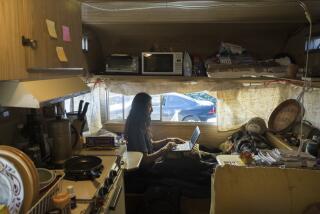KUCI-FM Prepares To Boost Its Power : * Radio: If the student-run station can raise money for new equipment, its strength will increase to 200 watts.
IRVINE — Born 22 years ago as a pirate radio station rigged up in a dormitory closet, KUCI-FM has evolved into a smartly run alternative-rock outlet with an ever-growing staff, budget and cult following.
But UC Irvine’s student-run station for years has been bursting at the seams of its feeble signal, which evaporates from one’s car radio within minutes of driving beyond the city limits.
“We’re too big for our britches,” says Shari Bagwell, the station’s general manager.
Soon, though, KUCI may finally get to loosen its belt a bit. The Federal Communications Commission recently approved the station’s request to boost its power more than eightfold.
If the station can raise the estimated $75,000 it needs to buy new equipment, within 18 months it will increase its strength from 24 to 200 watts. It will also convert to a signal that will make it easier to pick up on a car antenna, and for the first time, it will send out its intrepid musical mix in stereo.
Currently, KUCI (88.9) reaches from its campus transmitter to certain pockets in Corona del Mar, Anaheim, Tustin and Garden Grove. Station staff members expect the expanded signal will overcome daunting hillsides and other obstacles to reach listeners as far away as Placentia and Huntington Beach.
“We’ll definitely make it to the beaches” south of the campus, where potential listeners are now cut off by hills, Bagwell says.
The station made four previous attempts to apply for FCC approval but each time failed to complete the elaborate preliminary testing that is required. KUCI was stymied by being a relatively young station in one of the country’s busiest regions for radio airwaves. It shares the same frequency as KXLU, another alternative-music station, which broadcasts at 3,000 watts from Loyola-Marymount University in Los Angeles, reaching parts of western Orange County.
That problem was solved when the FCC relaxed restrictions on directional signaling. But still, things had gotten to the point where station staffers considered the signal boost “a pipe dream,” Bagwell says. “We never thought the FCC would approve it.”
The staff still faces an unprecedented fund-raising effort before that pipe dream can come true.
KUCI--which has never held any kind of on-air fund drive--needs a new directional transmitter, a wiring overhaul and a host of other logistical conversions to send out a stronger, richer signal. Officials hope to initially lease the equipment at a cost of $10,000 to $20,000 before coming up with the rest of the money needed to buy it.
Its first attempt at lobbying listeners for financial support is scheduled for Nov. 11-18. The station has also planned a benefit concert for Nov. 13 at Bogart’s in Long Beach, with a yet-undetermined lineup of bands.
Additional benefit concerts are likely next year, and station officials say they will be pushing harder for grants and other financial help of the sort that now supports the commercial-free station, which operates on a budget that topped $75,000 this year.
Bagwell says she hopes the station can complete the upgrade by the end of this school year, though she acknowledges that it’s an optimistic goal. Unless the station finishes the equipment make-over in 18 months, it must apply to the FCC for an extension.
Station officials say they are determined to make that deadline. “We’ve been prepping for an upgrade for years,” says program director Kevin Larson. Todd Sievers, the station’s music director and a four-year veteran of KUCI, says the staff has long approached its broadcasts as if it were reaching a wider audience.
One thing that won’t change with the signal, however, is the station’s format, officials say. Since its pirate days, KUCI has devoted itself to the cutting edge of alternative rock, slicing deeper than commercial stations.
On a typical weekday, KUCI listeners are likely to hear such modern bands as Mary’s Danish and Public Enemy, such old vanguards as David Bowie and a sampling of artists as obscure as the Poster Children Daisy Chain Reaction.
‘S omebody’s got to keep push ing the boundaries of music out, to be on the progressive edge of music,” says Bagwell. “And we think we do a pretty good job of it too.”
The station, which broadcasts around the clock, also airs specialty programs on jazz, folk music, reggae, classical music, gospel music, Christian and international music, along with daily public affairs shows.
Plus, there have been such on-air campaigns as an anti-censorship program last March, a “Day of Decency” broadcast run under the auspices of the University of California Radio Network that, staffers say, inspired other stations nationwide to follow suit.
“We try to do as much as we can with the limited tools we’ve had to work with and to affect as many people as possible,” says Bagwell. “To educate and inform--that’s what we’re all about.”
The format has been pretty much the same since the station began in November, 1969, within weeks of the day the university opened its doors. Enterprising students hooked up a crude transmitting device in a dorm closet and began broadcasting.
Soon after, when KUCI became licensed, its staff moved into a single room in the Physical Science Building, atop which the station transmitter still stands. In 1971, the station moved into several rooms on the second story of the Gateway of Commons Building on campus, where it has remained.
It also (unlike such larger college stations as KLON at Cal State Long Beach) has remained a student-run station, with only one paid worker among its staff of 70.
“We started as this little station in a closet, so there’s a tradition here that we’ve always believed in, to do what we want to do,” Bagwell says. “This station has always kept to its roots.”
More to Read
Sign up for Essential California
The most important California stories and recommendations in your inbox every morning.
You may occasionally receive promotional content from the Los Angeles Times.










